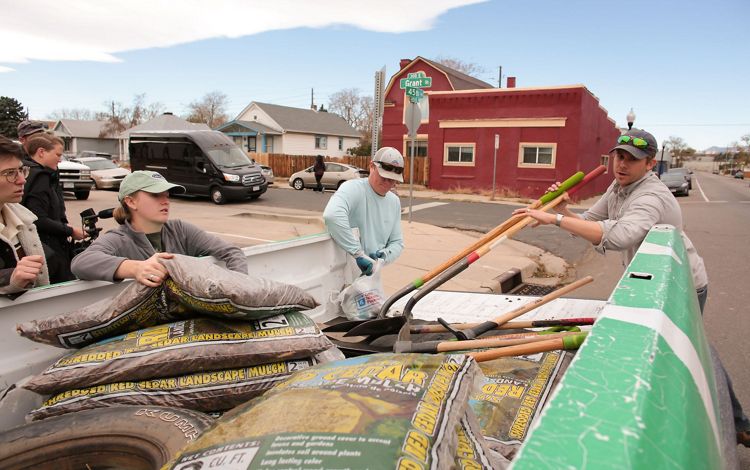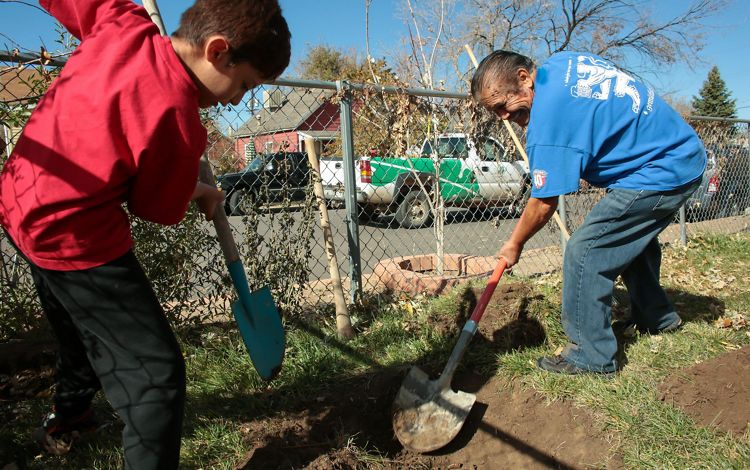Uniting Colorado’s Cities with Nature
Greener cities can support healthy, equitable communities, but a sustainable future starts with science-based planning and strong partnerships.
Our planet today is more urban than ever before. More than half of the people in the world now live in cities—and that growing population has important implications for conservation. At their best, cities can help solve global challenges like the biodiversity and climate emergencies by supporting and creating more sustainable, efficient ways of living.
Think globally, act locally
Updates from the conservation world and how you can get involved.
Colorado’s Front Range is home to most of the state’s largest cities, as well as diverse ecosystems. But as our climate continues to change, neighborhoods get hotter, demand for water outpaces supply, and air quality worsens, our more vulnerable populations—including the elderly, working families, and people of color—feel the brunt of these effects.
Our future in Colorado and around the world will be shaped by the ways we adapt and harness the potential of cities to address these challenges. So how can we make sure that cities help balance the needs of people and nature? According to science led in part by The Nature Conservancy (TNC), smart urban planning that advances nature-based community resilience, urban habitat connectivity, and equitable climate action can ensure we all thrive together—and the Denver metro area could lead the way.
Denver: Today and Tomorrow
-
Heat
The average number of days per year over 95° F is projected to increase from 5 days before the year 2000 to 35 days by 2040.
-
Growth
The Denver metro area is growing, with a projected population of 4.8 million people by 2050, compared to 3.5 million today.
-
Trees
Affluent neighborhoods in Denver have 7x as many trees as historically under-resourced neighborhoods.
In partnership with Metro Denver Nature Alliance, TNC developed a Regional Conservation Assessment that will help decision-makers identify lands and waters to connect, protect, restore, and enhance across the 6,200 square mile Denver region. This will answer questions such as: Where are the most important habitats for wildlife? How can we better connect parks, trails, rivers, and forests for people and nature to move between them? Which places are top priorities for restoring nature?
Ultimately, the goal is to facilitate collaborative planning across municipalities, with an eye toward climate resilience, connecting habitats, and increasing access to nature for people. With meaningful input from diverse partners and local communities, this tool will help create more equitable access to the benefits of nature for all those who live in Denver and surrounding communities.
Quote: Chris Hawkins
A dynamic regional vision for the Denver metro area will set us up for transformative change that leads toward a place where nature and people thrive.
Planting Trees for a Healthier Denver
Trees in cities provide a multitude of benefits to people who live around them. Picture yourself on a city street lined with large, old trees. The shade on your skin, the calming effect of green leaves above, and the way the vegetation quiets the noise of the city might be some of the first things you notice. Beyond that, trees help keep streets cool, improve air quality, and prepare neighborhoods for climate change. Research even shows that people are happier and healthier when they live in neighborhoods with more trees.

Unfortunately, in many cities, including Denver, the benefits trees provide are unequally distributed. Wealthy neighborhoods have an average of seven times more trees than poor neighborhoods.


This inequity can be attributed to a range of challenges, such as the history of redlining in Denver, a discriminatory practice of refusing to insure mortgages in neighborhoods with more African Americans and immigrant families. These decades-old policies still impact our neighborhoods today, as the maps of lower tree cover line up with historically redlined areas.


Together with partners, TNC has been working with local communities in the Denver neighborhoods including Globeville, Elyria Swansea (GES) to plant more trees and find holistic solutions for expanding the tree canopy across the city. TNC has helped organize community tree-planting events and built partnerships with community-based organizations and nonprofits that bring important youth engagement and tree expertise like Groundwork Denver, The Park People, and Globeville First.
Creating a Green City for All
Tree planting efforts in local communities are part of a bigger story.
“It’s the larger picture around policies to put more resources from the city into communities that have been historically ignored and disinvested in,” says Cindy Chang, with The Park People. “We’re focusing on making sure the GES community is getting the priority it deserves.”

Tree planting and planning at a large scale can also create job opportunities. TNC and partners have advised on a regionwide tree workforce development program.

“Building on this work to provide a model of what community-led tree planting can look like, we hope to see a citywide vision with neighborhood-level planning and goals, as well as a task force that meets regularly and is dedicated to advancing equity,” explains TNC’s Chris Hawkins. “We want to direct funding to community-led groups to advance tree planting and other local priorities.”
In partnership with the University of Colorado’s Masters of the Environment program, four graduate students researched best practices for creating a more equitable urban forest. The students conducted a literature review and over 50 interviews with stakeholders in cities around the U.S. and presented their findings to leaders in the City and County of Denver at the first-ever Urban Forestry Roundtable. This roundtable is the first critical step in kicking off a citywide master planning effort set to launch later this year.
The graduate student research team commented, “Presenting to the City of Denver was a great opportunity for our team to share the findings of our nationally influenced research on the intersections of equity, climate resilience, and the built environment within urban forestry. While our research suggests that tree inequities are prevalent throughout the U.S., it’s encouraging to see that many cities are working towards meaningful community engagement and enhanced collaboration to achieve truly equitable outcomes.” The research team includes graduate students Kayli Skinner, Kiana Seto, Lorena Gonzalez, and Melissa Englund.
Globeville, Elyria Swansea



Investing in Nature Now for Colorado’s Future
Choices about how and where our Front Range cities grow—including density, transportation, water and energy use, and managing and integrating nature—will be critical in shaping Colorado for decades to come. By focusing on nature-based community resilience, urban habitat connectivity, and equitable climate action, Denver communities are investing in our state’s future.
“Cities are a conservation strategy unto themselves,” Hawkins says. “If we want to solve big conservation issues like protection of wild spaces, we have to get cities right.”
Our future must be one in which nature and people are connected. That means that our cities should be planned with both people and nature in mind, and with a long-term vision to guide decisions made today.







